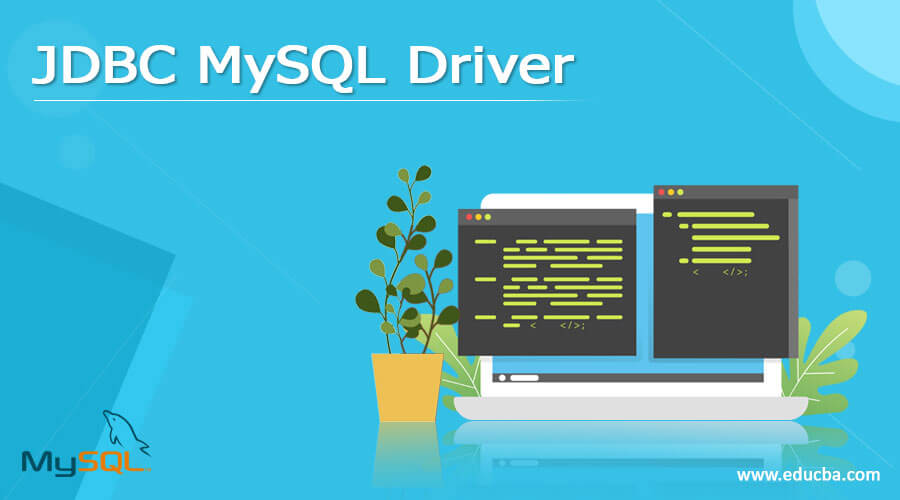Updated June 1, 2023

Definition of JDBC MySQL Driver
Sun Microsystems build the APIs based on Java database connectivity to embed on the JDBC driver. It provides a structured method to work on the data by using Java. With the help of JDBC, any application can manage different kinds of databases which can be executed on any platform using a Java virtual machine. Here, the MYSQL JDBC driver allows users to combine with live MYSQL data from any application based on JDBC connectivity. It develops and deploys a strong Java application that integrates with the compact database engines of MYSQL.
What is JDBC MySQL Driver?
To establish a connection between Java and MySQL, you must use the MySQL JDBC driver, also known as the MySQL connector. This driver allows for converting SQL-92 queries to MySQL syntax and supports secure access to MySQL through embedded SSH tunneling. Moreover, the wire protocol driver is compatible with the client protocol of MySQL. Here are the features and specifications of the JDBC MySQL driver. The tunneling on embedded SSH allows secure connections to the remote databases of MySQL.
How to use it?
The JDBC connects Java-based applications to various databases, analytical tools, ETL, reporting, and BI. It establishes connectivity through JDBC and allows reading and writing data. Popular platforms like ColdFusion, CloverDX, Aqua data studio, Crystal Reports, DBeaver, Filemaker Pro, DB Visualizer, Informatica, IBM WebSphere, JBoss, NetBeans, Jetty, IntelliJ, Oracle Warehouse Builder, Oracle Data Integrator, Oracle WebLogic integrate with the JDBC. The integration with MySQL offers a solution like MariaDB, Amazon RDS, Amazon Aurora, Google Cloud SQL, and so on. To establish real-time access, it connects with live MySQL data. The support for aggregation in data and builds complicated JOINs in queries of SQL. The connection is secured via modern cryptography, including SHA-256, TLS 1.2, and ECC. It can be integrated into reporting, BI, and ETL tools and connect with customized applications. The compute Java with JDBC driver for MySQL has access bi-directional. The user can compose SQL, fetch MySQL data, and access MySQL via standard Java database connectivity. The integration to code can be possible with famous ETL tools, BI, and reporting. It has entire Unicode support for metadata, parameter, and data. It also supports 64-bit and 32-bit operating systems.
Connecting to MySQL Using the interface of JDBC Driver Manager
When the user uses the JDBC external to an application server, the DriverManager implements the connection establishment. It can be specific to the driver manager where JDBC drivers try to establish a connection. The simple way to use this classforname() on the class, which has the java.sql.driver interface. With MySQL’s connector, this class’s name can be com.mysql.jdbc.driver. By using this technique, the user can use the external config file to feed the driver class name and parameters of the driver to imply when linked with the database. The code in Java explains hows the SQL connector registers the main() of the application. Before testing the code, it is crucial to complete the installation process. This includes appropriately installing the connectors in the Classpath setup and configuring MySQL to hold the TCP or IP connection established externally. After registering the driver with Drivermanager, the user can select a connecting instance linked to the appropriate database by calling drivermanager.getconnectivity(). The below example program shows how a connecting instance can be chosen from the drivermanager. There are many signature methods to establish the getconnection() method. Please go through the API connection associated with JDK to get specific information on how to use them. So once the connection is set up, it is used to develop and statement and objects of a prepared statement. It can also retrieve the metadata from the database.
import java.sql.Connection;
import java.sql.DriverManager;
import java.sql.SQLException;
// Note, do not import com.mysql.jdbc.*
// or you will get errors!
public class Educba {
public static void main(String[] args) {
try {
// The newInstance() created is a temprory solutions for few
// broken Java implementations
class.CourseName("com.mysql.jdbc.Driver").newInstance();
} catch (Exception ) {
// manages the error
}
}
}MySQL Installation Examples
First, ensure that MySQL can be executed or supported in your platform. Because the platform doesn’t support MySQL, it can be executed only in a few officially organized Oracle Corp. Select in which distribution or part to install. A few versions of MySQL are available in several distribution formats. So the user can select the pre-packaged distribution comprised of precompiled source code. If the user doubts applying the binary distribution, Oracle offers access to the source code of MySQL to view the recent development and test the newly built code.
You need to download the distribution and complete the necessary post-installation setup to install it. You can install the distribution on different operating systems like Linux, Unix, FreeBSD, Microsoft Windows, and macOS.
The free or available instruction on MySQL is based on Unix and Linux platforms by generic binary packages. MySQL’s entire source code distribution is available in the repositories of source code. This tool can assist with installing, configuring, and building from sources based on the platform used. It is compatible with Solaris through the IPS format and PKG and supports various processes on IBM AIX and Linux platforms. There are options for Zipped binaries or MySQL installers for installation on Microsoft Windows. Microsoft Visual Studio can help you build MySQL on Windows from source code. To install MySQL on macOS, it includes both native PKG and binary package formats. It also offers the information to automatically launch the Daemon on macOS to start and stop the process in MySQL.
Conclusion
The JDBC MySQL driver is a versatile tool connecting a Java application with a MySQL database across various platforms. It’s important to note that this driver requires active participation and cannot function passively.
Recommended Articles
We hope that this EDUCBA information on “JDBC MySQL Driver” was beneficial to you. You can view EDUCBA’s recommended articles for more information.

